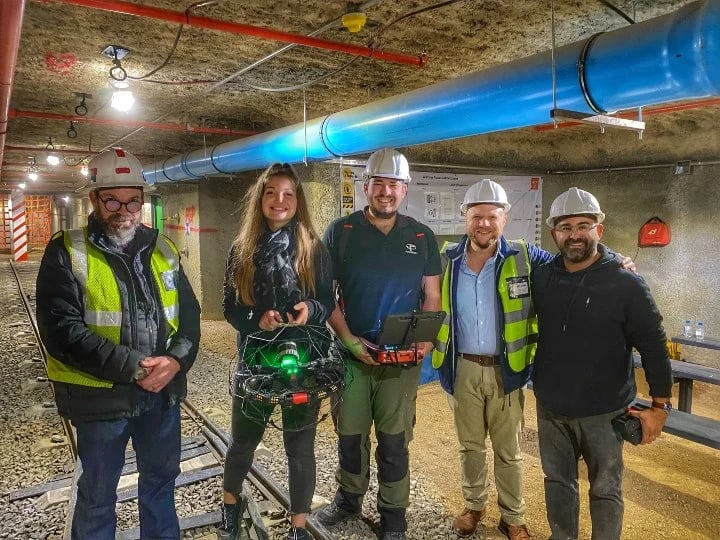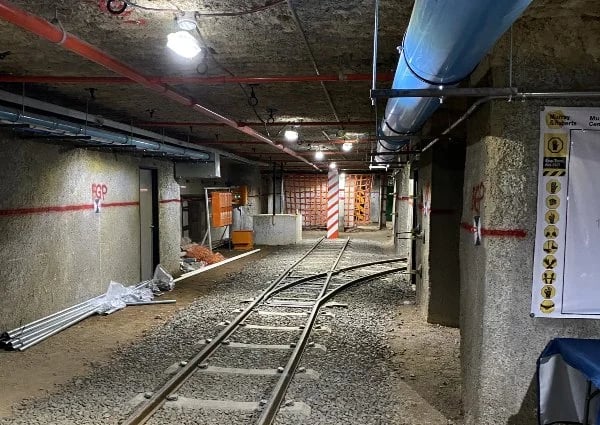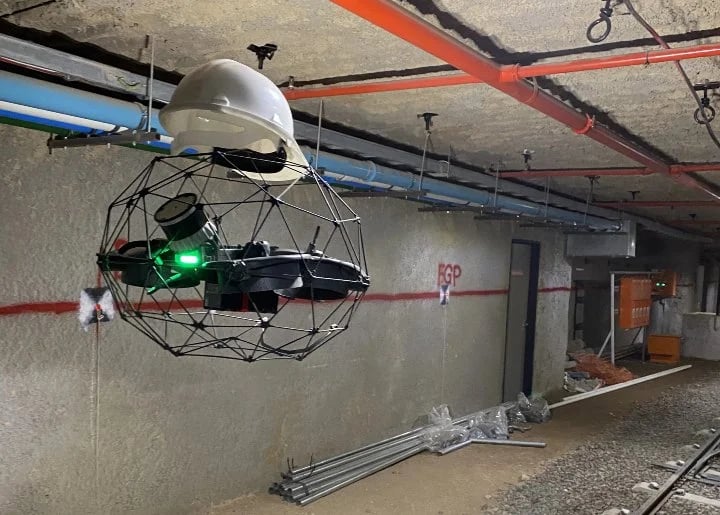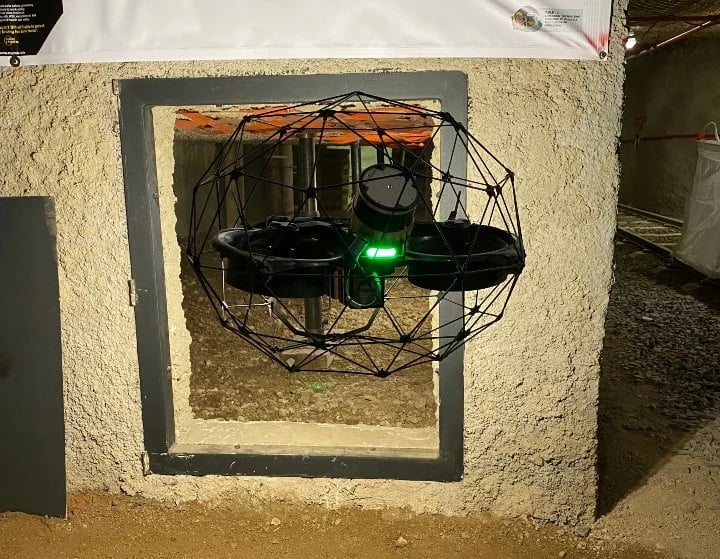- Case Studies >
- Drones for Mining in South Africa: An Interview with...
Drones for Mining in South Africa: An Interview with Hendrik Grobler of the University of Johannesburg
What does the landscape look like for drones in South African mining? Read this interview with Hendrik Grobler, Head of the Department of Mining Engineering and Mine Surveying at the University of Johannesburg to find out.
In this interview, we hear from Associate Professor Grobler about the adoption of drones in South Africa for mining, including the use of drones to improve safety, efficiency, and data collection in mining operations.
What has been your career path with mining in South Africa?
I graduated in 1991 with a mine surveying qualification from the Department of Mining Engineering and Mine Surveying at the University of Johannesburg.
In South Africa, those working in mining also need to receive an additional qualification, called a Government Certificate of Competency. I passed the exam for mine in 1994, and I went on to work in gold, nickel, and platinum mines for the next thirteen years.
And in 2007 I began teaching at the University of Johannesburg, in the same department where I originally earned my first qualification.

Associate Professor Grobler with representatives from Flyability and GammaTec
Tell us about the Mining Engineering and Mine Surveying Department at the University of Johannesburg. What does the department do?
The Mining Engineering and Mine Surveying Department will turn 100 in 2026, so we’ve been active for quite a long time.
The department offers a bachelor's degree in mining engineering and a bachelor's degree in mine surveying, and we also offer honors and masters projects after that. We currently train about 600 mining engineers and mine surveyors a year through the four degree courses we offer.
Employability is a strong area of focus for the department. Most of our students are either already working in the mines before they even start studying with us, or go directly into this work after completing their studies.
What kind of unique training facilities do you have in the department?
A couple of years ago we built a tunnel on campus that could act as a simulation mine. To build the simulation mine, we accessed a basement that had a shaft and developed a typical mine layout in it. This was a very special project—currently, there are only a handful of simulation mines in the world.
The tunnel is used for undergraduate training, so that we don't have to take students to an actual mine every day in order for them to study mining in a hands-on manner.

A picture of the simulation mine
We also use the tunnel for testing and demonstrating new technology. When we encounter new technology like drones or robots being used in mining, we can take it to the tunnel and practice with it there. We have operated the Boston Dynamics Spot robot there, as well as Flyability’s Elios 3.
In addition to the tunnel, the department has also built an extensive virtual reality platform for its students. We have a hydraulic drill rig and a blasting wall where our students can practice placing explosives and blasting them in a virtual reality environment.
How are drones being used in mining?
Surveying and inspections are the two primary use cases we see for drones in mining.
According to regulations, we have to update our surface plans every three months to a year. A drone can help do this work, so that people don’t have to walk around and expose themselves to extreme conditions to get this data.
For inspections, drones can be used inside mines to collect visual and LiDAR data inside unstable areas of the mine, to investigate the cause of hangups, and to generally improve our understanding of different areas underground.
What are the advantages of using a drone in mining?
Two big advantages are safety and efficiency. Using the drone to measure volumes on the surface means a significant saving in time and reduces the risk exposure of the surveying teams
There’s also the efficiency of having a remote data collection tool that can enter unstable or hard-to-reach areas underground and quickly collect high quality data there.
This data can benefit several people involved in the mining operation, including the mechanical engineer, the shaft engineer, the surveyor, and the geologist. This one tool—the drone—equipped with just one sensor can provide four people with information they need for their work.
Safety is also a benefit I see for helping with emergency situations. We had a situation recently where rescuer workers died due to extreme heat while trying to find someone who had been reported missing within a mine. The situation was terrible.
Mines in South Africa can be incredibly hot. Rescue teams working in extremely hot, poorly ventilated areas stand the risk of being overcome by these conditions.
With a drone, you could have flown it down into the area looking for the missing person, and also measured the temperature and evaluated the situation remotely before taking the risk of entering in person.
Although we have drastically improved our health and safety practices in South Africa when it comes to mining, one fatality is too much. Mining is a massive industry here—we have about half a million people working in mining right now, and therefore any technology that can contribute to saving lives is eagerly welcomed.
And this is where remotely operated equipment like drones can help. Eventually, drones may help bring that number all the way down to zero.
What are some concerns you have about how people are using drones for work in mines?
South Africa has some very rigid drone licensing requirements, but we’re finding that some mining operations are using drones without having their pilots obtain a commercial drone license or properly license their drone.
If a mining company is caught operating an unlicensed drone it could potentially get in a lot of trouble, including fines and criminal charges from South Africa’s Department of Mineral Resources.
There’s also an issue with training, where we’re seeing people not get the proper experience needed before they begin to use a drone for work at a mine.
So we're trying to get the message across that not only do you need to be compliant with the law, you also need proper training. Just because you own a cheap consumer drone doesn’t mean you can take it into a mine and start using it for work there.
How do you think Flyability’s Elios 3 can benefit work in mining?
The Elios 2 was the first Flyability drone I ever saw. The first thing that struck me was the roll cage, which is a good idea for an anti-collision device.
But the Elios 2 needed some improvements for stability. For any surveyor stability is the first test. If a drone isn’t stable, then we don’t trust the data it collects.
But all these stability issues have been addressed with the Elios 3.
The Elios 3 is incredibly stable. In fact, the other day, when we were testing the Elios 3, we actually put a hardhat on top of the drone and it didn’t move at all.

I also like that you can rotate the camera up and down with the Elios 3. We were actually able to use the Elios 3 to identify survey points or pegs in the roof and the side wall of an excavation by swiveling the camera.
The Elios 3 carries a LiDAR sensor. What benefits can mining operations realize by using an indoor drone equipped with LiDAR sensing?
The fact that there's LiDAR on the Elios 3 now makes it more than an inspection drone—it’s also a drone for mapping inaccessible areas and block caving, which lets you immediately see the full dimensions of these spaces. It's an incredibly useful tool for what we need.
Compared to photogrammetry, LiDAR has the advantage of not needing lighting.
LiDAR can penetrate dust and smog, which we get a lot of in mining. Especially in very hot environments, which we often encounter in South African mining, your visibility can be reduced to less than two meters (6.5 feet). So LiDAR data is great for mining, because we can use it regardless of any visibility issues you encounter.

The Elios 3's LiDAR sensor glows green as it flies in the simulation mine
LiDAR sensing can also help you fly even when you can’t see, since you can create a 3D map in real time that shows you where the drone is.
I also like that LiDAR allows you to pick up textures and sometimes contacts. We've done a lot of terrestrial mapping underground with aerial LiDAR, and we’ve been able to use it to pick up geological hazards, like faults and dykes.
Hangup inspections in ore passes are another area where LiDAR really helps. These are shafts that are vertical or just off vertical, where there could be hangups or clogs caused by mud or other obstructions.
What does the future of drones look like for mining operations in South Africa?
Right now we’re still in the fairly early stages of adoption with drones for mining in South Africa.
For some people, they wonder if drones and other robotics tools like the Spot are just technology looking for a solution, and whether we actually need tools like these.
I don't think this is the case.
If we are serious about making our work in mines safer, we need to start using drones. And in reality, I think drones have already proved themselves in the mining industry in South Africa. I don't think there's any mine currently operating in the country that does not have some form of drone technology on site, or have immediate access to drone technology nearby.
So the main thing we need to do now is to mainstream this technology and help drive wider adoption.
Rather than just having mines hiring drone pilots as contractors who come in and do a little bit of an inspection work and then leave, my opinion is that each mining house should own at least one drone like Flyability’s so that they can rotate it between their operations.
Ideally it would be wonderful to have even more drones on site, with one on each shaft. This would allow you to actually map your ends on a daily basis, or at least a weekly basis.
Interested in learning more about the Elios 3 in mining? Check out our industry page!


.png)


















